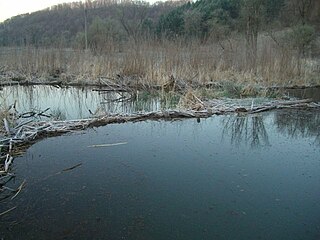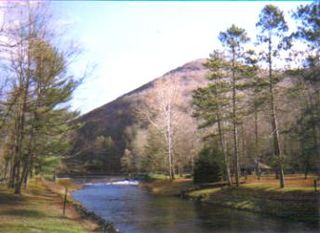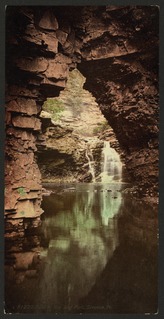
Swamp Creek is a tributary of the Flambeau River in northern Wisconsin, USA. [1] The Flambeau is in turn a tributary of the Chippewa River.
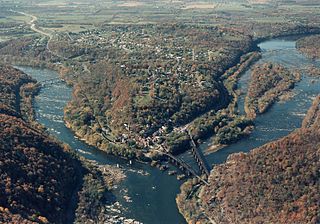
A tributary or affluent is a stream or river that flows into a larger stream or main stem river or a lake. A tributary does not flow directly into a sea or ocean. Tributaries and the main stem river drain the surrounding drainage basin of its surface water and groundwater, leading the water out into an ocean.

The Flambeau River is a tributary of the Chippewa River in northern Wisconsin, United States. The Chippewa is in turn a tributary of the upper Mississippi River. The Flambeau drains an area of 1,860 square miles (4,800 km2) and descends from an elevation of approximately 1,570 feet (480 m) to 1,060 feet (320 m) above sea level. The Flambeau is an important recreational destination in the region. It is notable among canoeists in the Midwest for outstanding canoe camping, including excellent scenery, fishing and whitewater. The river and its forks have a variety of possible trip lengths from short day outings, to overnight camping, to voyages of a week or more.

Wisconsin is a U.S. state located in the north-central United States, in the Midwest and Great Lakes regions. It is bordered by Minnesota to the west, Iowa to the southwest, Illinois to the south, Lake Michigan to the east, Michigan to the northeast, and Lake Superior to the north. Wisconsin is the 23rd largest state by total area and the 20th most populous. The state capital is Madison, and its largest city is Milwaukee, which is located on the western shore of Lake Michigan. The state is divided into 72 counties.
Swamp Creek is the largest of 23 streams which flow into the Flambeau River, and one of a few which have a dam. The other remaining tributaries of the Flambeau River are fairly small, but many support trout populations. [2]

A dam is a barrier that stops or restricts the flow of water or underground streams. Reservoirs created by dams not only suppress floods but also provide water for activities such as irrigation, human consumption, industrial use, aquaculture, and navigability. Hydropower is often used in conjunction with dams to generate electricity. A dam can also be used to collect water or for storage of water which can be evenly distributed between locations. Dams generally serve the primary purpose of retaining water, while other structures such as floodgates or levees are used to manage or prevent water flow into specific land regions. The earliest known dam is the Jawa Dam in Jordan, dating to 3,000 BC.

Trout is the common name for a number of species of freshwater fish belonging to the genera Oncorhynchus, Salmo and Salvelinus, all of the subfamily Salmoninae of the family Salmonidae. The word trout is also used as part of the name of some non-salmonid fish such as Cynoscion nebulosus, the spotted seatrout or speckled trout.
The Flambeau River rises in two major forks—the North Fork and the South Fork. Swamp Creek is located in the watershed of the North Fork, which is near the Turtle-Flambeau Flowage in Iron County. Swamp Creek is one of four other named creeks in the watershed of the North Fork, the others being Bosner Creek, Smith Creek, and Sixmile Creek. [3]

A drainage basin is any area of land where precipitation collects and drains off into a common outlet, such as into a river, bay, or other body of water. The drainage basin includes all the surface water from rain runoff, snowmelt, and nearby streams that run downslope towards the shared outlet, as well as the groundwater underneath the earth's surface. Drainage basins connect into other drainage basins at lower elevations in a hierarchical pattern, with smaller sub-drainage basins, which in turn drain into another common outlet.

The Turtle-Flambeau Flowage is a 12,942 acre lake, located in Iron County, Wisconsin. It has a maximum depth of 50 feet. Fish include Musky, Panfish, Largemouth Bass, Smallmouth Bass, Northern Pike, Walleye and Sturgeon. The lake's water clarity is low.
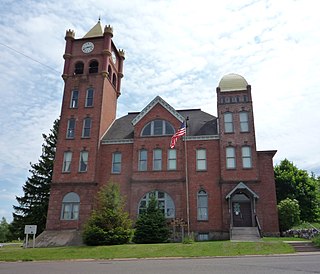
Iron County is a county located in the U.S. state of Wisconsin. As of the 2010 census, the population was 5,916, making it the third-least populous county in Wisconsin. Its county seat is Hurley. It was named for the valuable iron ore found within its borders.
Forest Wander Lake 17 is a 39-acre impoundment of Swamp Creek in Iron County. [4]
Most of Swamp Creek is classified as a Class II Trout Stream. [5] Streams in this classification may have some natural reproduction, but not enough to utilize available food and space. Therefore, stocking is required to maintain a desirable sport fishery. These streams have good survival and carryover of adult trout, often producing some fish larger than average size. There are 5,911.6 miles of Class 2 trout streams in Wisconsin and they comprise 45% of Wisconsin's total trout stream mileage. [6]
